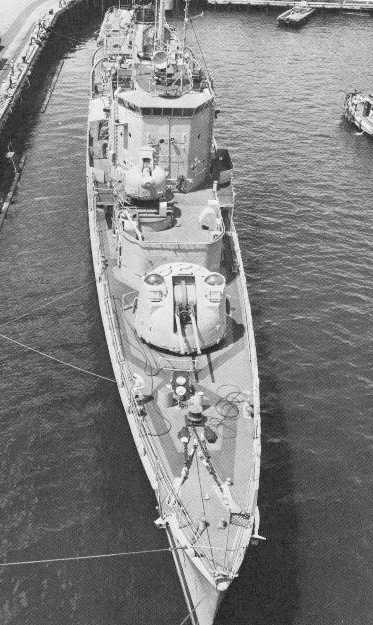These guns had their genesis in the Kamikaze attacks of World War II. A larger-caliber projectile was needed to replace the 20 mm Oerlikon and 40 mm Bofors automatic weapons as they had proven to be too small to kill-stop suicide planes. This need led to the accelerated development of 3"/50 (7.62 cm) guns equipped with autoloaders and later to the 3"/70 (7.62 cm) project. The 3" (7.62 cm) caliber was selected for these weapons as it represented the smallest-size projectile that could still be fitted with a VT (radar proximity) fuze. BuOrd considered the 3"/70 (7.62 cm) twin mounting to be superior to the single 5"/54 (12.7 cm) Mark 42 for defending against fast aircraft and guided missiles.
The development of the ammunition and water-cooled barrel was a joint British-American project, but each navy designed a completely different gun mounting, with the British one being the 3"/70 (7.62 cm) Mark VI.
This twin mount was intended to replace the older 5"/38 (12.7 cm) Mark 12 mounts on a one-for-one basis and to become the standard weapon for post-war destroyers. However, its complex nature resulted in a long development cycle and by the time it was ready for service use in 1956 the usefulness of antiaircraft shellfire was limited. In addition, the mounting proved to be so unreliable and hard to maintain that it was quickly withdrawn from duty and may have had the shortest service life of any weapon system ever used by the US Navy. It has been said that the only advantage of this mounting was that the gun shield let you work on them out of the weather. Most mounts were replaced within a few years with other weapons and the only US warship to retain the 3"/70 (7.62 cm) to the end of her career was USS Norfolk (DL-1).
As per the nomenclature change in the US Navy after World War II, the Mark 37 designation was for the mounting, not the gun itself. The gun went through four major revisions. The Mark 23 was a prototype used to test the operation of fully-automatic firing. The Mark 24 was similar but slightly lighter. The Mark 25 used a rapid-fire horizontal-wedge breech. The Mark 26 was the service version and was a water cooled monobloc tube and liner with a horizontally sliding breech mechanism. The liner was secured at the breech end by a liner locking ring. The tube had twelve grooves on the inside to circulate coolant. The coolant circulated from a reservoir at the base of the central column, being pumped to the recoil brake and transfer mechanism and then to the breech of the gun. From the breech, the coolant traveled to the muzzle through the coolant grooves in the tube and at the muzzle passed through a collector ring and was returned via external piping along the top of the barrel to the reservoir. The liner on this last Mark had a three caliber smoothbore section near the muzzle (Probertised) to reduce loss of velocity and to act as a flash suppressor. The breechblock opened mechanically as the gun recoiled and closed automatically as soon as the next round was loaded. The barrel is attached to the breech ring by interrupted threads (bayonet joint) and can be removed without dismounting the gun.
Two mountings from USS Norfolk (DL-1) still survive and were originally on display at the Recruit Training Center (RTC) Orlando, Florida. After the center closed in the mid-1990s, they were moved to the Boca Raton Community High School in Florida. The two mounts were later moved to Naval Station Norfolk in 2020.
| Designation | Weapon: 3"/70 (7.62 cm) Marks 23, 24, 25 and 26
Mounting: Mark 37 Mod 0 |
|---|---|
| Ship Class Used On | Prototype was tested on Carpenter (DDE-825)
Northampton (CLC-1), Norfolk (DL-1) and Mitscher (DL-2) classes |
| Date Of Design | 1945 (initial) 1 1956 (final) |
| Date In Service | 1958 |
| Gun Weight
(not including breech block) |
Mark 23: 1,875 lbs. (850 kg)
Mark 24: 1,853 lbs. (841 kg) Mark 25: 2,073 lbs. (940 kg) Mark 26: 2,650 lbs. (1,202 kg) |
| Gun Length oa | N/A |
| Bore Length | 210 in (5.334 m) 2 |
| Rifling Length | N/A |
| Grooves | N/A |
| Lands | N/A |
| Twist | Uniform RH 1 in 25 |
| Chamber Volume | N/A |
| Rate Of Fire | 90 - 100 rounds per minute |
- ^In 1945 BuOrd estimated that this gun would take four years to develop. It actually took nearly three times as long.
- ^The bore is chrome plated.
| Type | Fixed |
|---|---|
| Weight of Complete Round | 36 lbs. (16.4 kg)1a |
| Projectile Types and Weights 2a | AA Mark 34 Mod 1 3a: 15 lbs. (6.8 kg) |
| Bursting Charge | N/A |
| Projectile Length | N/A |
| Propellant Charge | 11.2 lbs. (5.1 kg) SPD
Cartridge weight (empty): 9.8 lbs. (4.4 kg) |
| Cartridge | Mark 10 - 76.2 mm x 669R |
| Muzzle Velocity | 3,400 fps (1,036 mps) |
| Working Pressure | 22.5 tons/in2 (3,547 kg/cm2) |
| Approximate Barrel Life | 2,050 rounds |
| Ammunition stowage per gun 4a | Norfolk: 1,110 rounds
Mitscher: 1,000 rounds Others: N/A |
- ^"US Naval Weapons" incorrectly shows the complete round weight as being about 62 lbs. (28 kg).
- ^These guns fired a new, heavier projectile than did older USN 3" (7.62 cm) guns.
- ^The fuze used for the AA projectile was normally a VT (proximity) type. It could be used in a contact mode by "paralyzing" the VT mechanism via a wiping action.
- ^There were a maximum of 77 ready rounds for each gun in the ammunition feed system.
| Elevation | Range |
|---|---|
| 45 degrees | 19,500 yards (17,830 m) |
| AA Ceiling | about 38,000 feet (11,580 m) |
| Designation | Single Mounting 1b N/A: Mark 35 Mod 0 Twin Mounting
|
|---|---|
| Weight | 125,500 lbs. (56,926 kg) |
| Elevation | -15 / +90 degrees |
| Elevation Rate | 35 degrees per second |
| Train | 360 degrees 3b |
| Train Rate | 50 degrees per second |
| Gun recoil | 15.62 in (40 cm) |
| Loading Angle | Any |
- ^The single mounting did not enter service use. Unless otherwise noted, all information in this section is in regards to the Mark 37 twin mounting.
- ^USS Carpenter was originally a Gearing class (DD-710) destroyer that was first commissioned as an ASW destroyer (DDK) in 1949. As completed, she carried two twin 3"/50 (7.62 cm) mountings. In the early 1950s she was rebuilt as a test bed for the 3"/70 (7.62 cm) and she then carried two of these prototype weapons, mounted bow and stern. The 3"/70 (7.62 cm) mountings were removed in the mid-1960s and she was then fitted with a standard 5"/38 (12.7 cm) Mark 38 twin mounting on the bow and a helicopter landing area in place of the stern mounting.
- ^The mounting uses slip rings and can be continuously rotated throughout 360 degrees.
- The requirement for a very high rate of fire for these guns meant a complicated loading system. Rounds were stowed horizontally in a 60-round cross feed, which loaded them into a 10-round elevator, which in turn loaded them into a 2-round transfer mechanism. The transfer mechanism fed the rounds into an ammunition hoist holding four rounds in clamps. This mechanism delivered the rounds up in front of the gun trunnion, over it, and into the rammer behind the gun. This very complex arrangement was needed in order to allow the gun to elevate to 90 degrees. The rammer itself was a power-operated cylindrical case which pivoted sideways to place the round just behind the breech, quickly moving forward and then abruptly stopping, catapulting the round into the breech..
- This mounting was a base-ring type and the guns shared a single slide. The sliding-wedge breech blocks were arranged horizontally to permit very close placement of the guns, whose centers are only 32 inches (81.3 cm) apart, and thus minimize the dimensions of the mounting. Nonetheless, the Mark 37 mounting considerably outweighed a twin 5"/38 (12.7 cm) destroyer mounting and required weight compensation when installed on the Mitscher class destroyers..
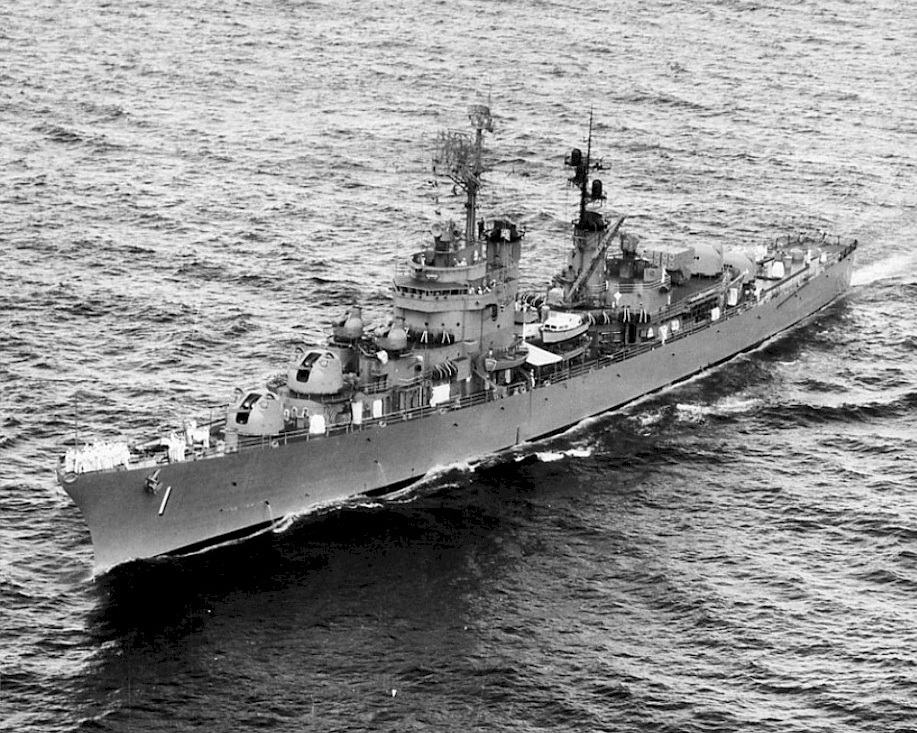
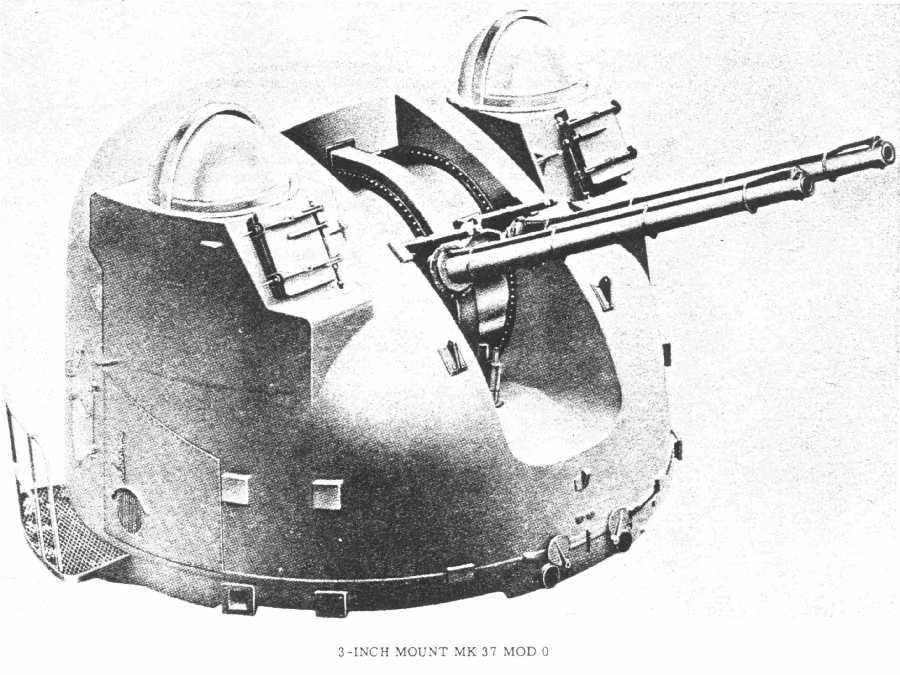
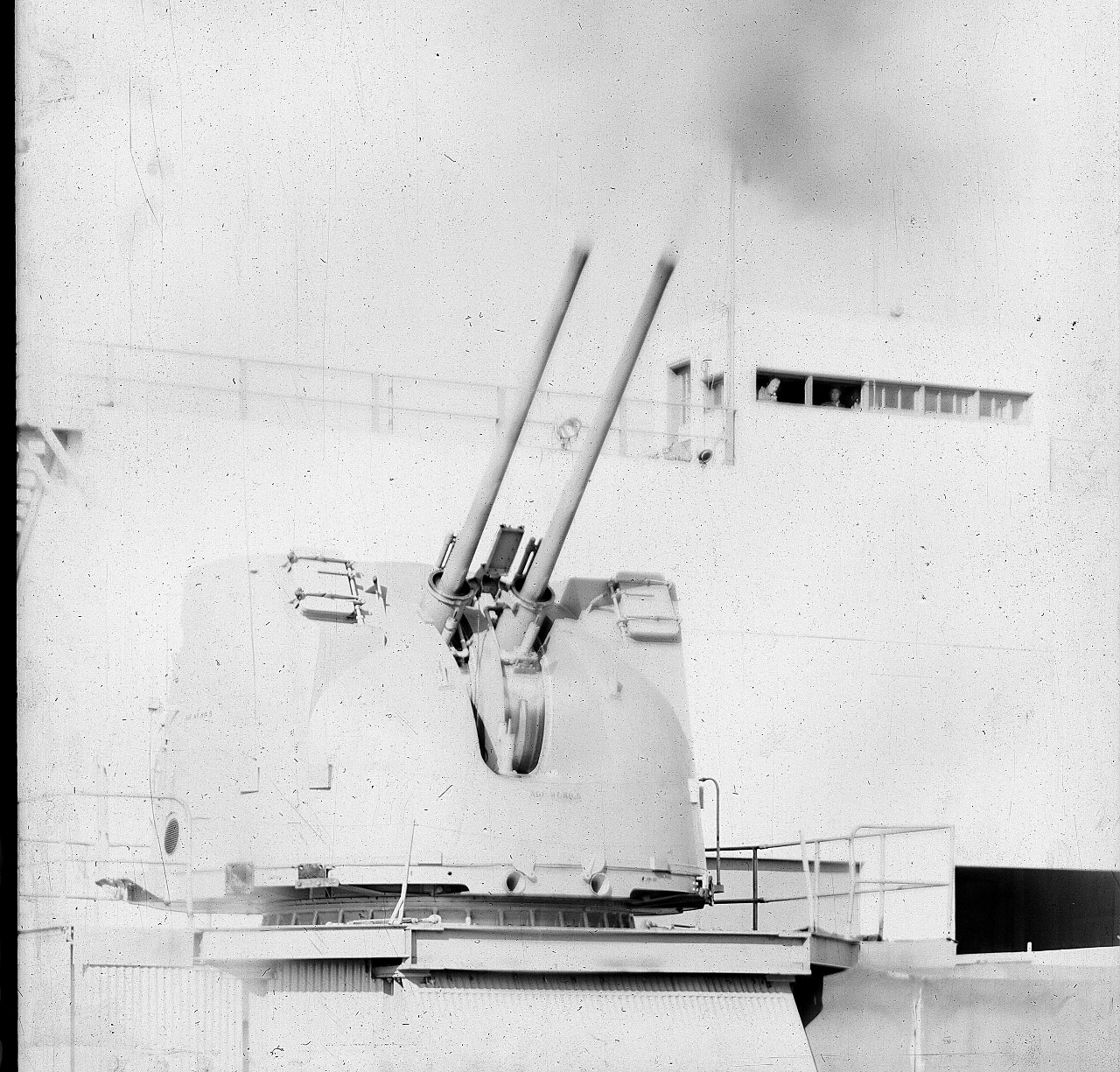
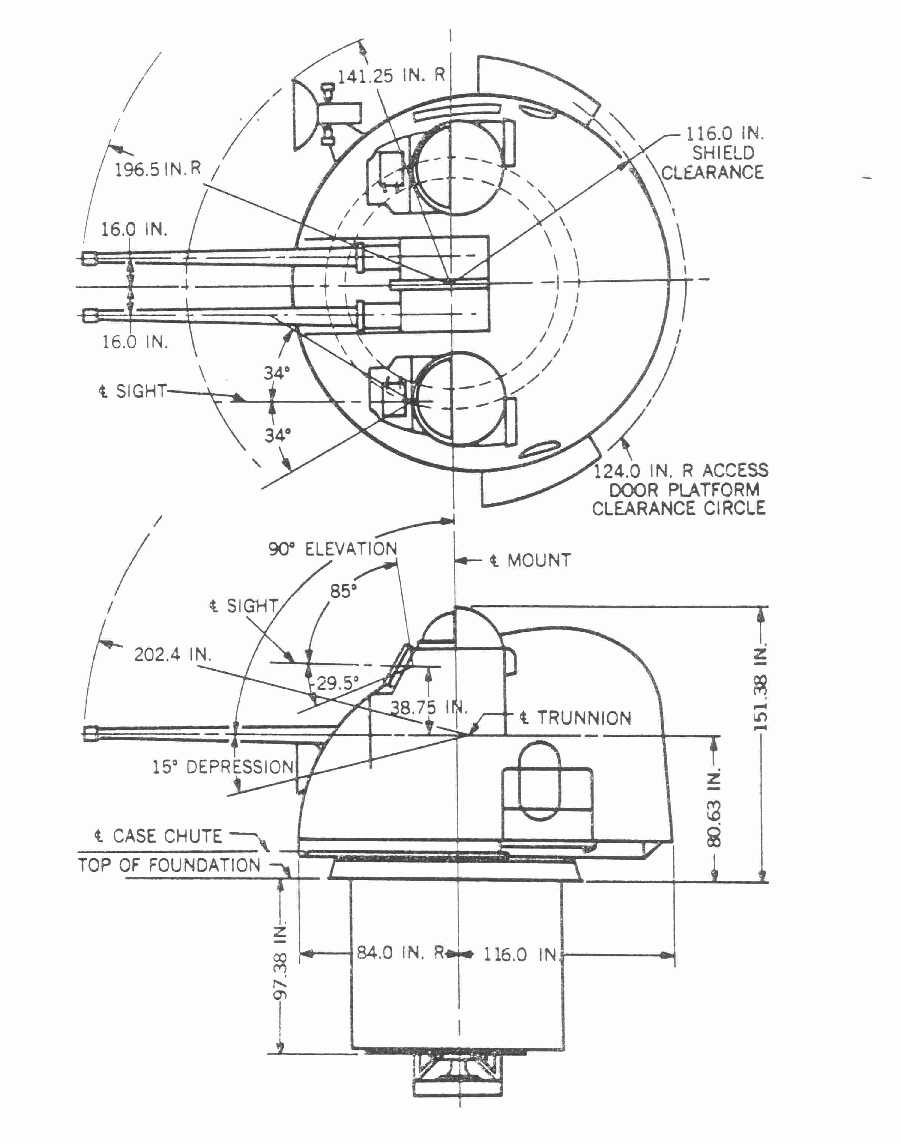
Scott Beale's Flickr album
Norfolk Mountings
"Naval Weapons of World War Two" by John Campbell
"US Destroyers: An Illustrated Design History" and "US Naval Weapons" both by Norman Friedman
"Sumner-Gearing-Class Destroyers" by Robert F. Sumrall
---
"Drill for 3 Inch Twin Mark 6 A.A. Mounting" produced by Weapons Division in Fleet School C.F.B. Halifax (1970)
"Test Firings of 3 IN./70 Caliber Single Mount Mark 35 Mod 0, Report AD0499511" by E.S. Romero, Naval Proving Ground Dahlgren, Virginia
---
Special help from Leo Fischer, Anthony G. Williams and Cameron M Balaban
12 February 2008 - Benchmark
26 June 2009 - Added comment regarding surviving Norfolk mounts and off-site link to photographs
23 August 2017 - Added information on surviving mounts and photograph of USS Norfolk DL-1
16 January 2019 - Converted to HTML 5 format, reorganized notes and added Dahlgren photograph
11 August 2023 - Added information about gun construction
26 April 2024 - Noted that mountings were moved to Naval Station Norfolk

